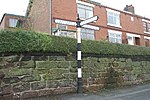Weaver Junction
Weaver Junction is a railway junction connecting the West Coast Main Line (WCML) with the Weaver Junction–Liverpool line, opening on 1 April 1869. Trains bound for Liverpool from London diverge from the WCML at this junction. Weaver Junction is the oldest flying junction in Britain, and also the world.The junction between the main line to Warrington and the north, and the direct line to Runcorn and Liverpool was originally from the date of opening in 1869, a flat junction at Birdswood. The flyover carrying the Liverpool line over the main line at Birdswood was not opened until 13 November 1881. The junction is now located some 0.75 miles (1.21 km) south of its former location and known as Weaver Junction. At initial construction, it avoided the need for both a diamond crossing and a conflict of routes.Its location is strategic and is considered a high importance freight corridor. The Weaver Junction area is classed as congested infrastructure when discussed in Parliament in connection with High Speed 2.
Excerpt from the Wikipedia article Weaver Junction (License: CC BY-SA 3.0, Authors).Weaver Junction
Tunnel Top South,
Geographical coordinates (GPS) Address Nearby Places Show on map
Geographical coordinates (GPS)
| Latitude | Longitude |
|---|---|
| N 53.3028 ° | E -2.6396 ° |
Address
Tunnel Top South
Tunnel Top South
WA4 4LA
England, United Kingdom
Open on Google Maps








